It was a desperate day in search of new water. I knew that the season was getting late, so if I were to see one of the last unexplored rivers within driving distance of Northern Virginia, I had to act fast. I conned Lon into going on this trip, and our mutual intent was to exploit Dragon Run, given that the Flyfisher’s Guide to Virginia assured us that there were “lots of fish” in this water.
However, Hart indicated that the best way to fish in this river was in a canoe. The technique he recommended was to drop the canoe in the water and move up or downstream from the launch point wading when possible. He commented that late in the season, the water gets exceptionally low, and canoeists end up spending much of their day dragging the canoe. Since it was September, we assumed that the water would be low and easily accessible without the hassle of a canoe.
Driving south on Route 17, we hopped off at the town of Center Cross to head to the first access point off Route 604. What a disappointment! It’s hard to imagine anyone launching a canoe here. The river was about 20 feet wide – at most – and a deep brown swamp color. The water appeared to be high, which was clearly unwadeable in this stretch. Since we had driven over an hour from Fredericksburg to this point, we decided to continue south to see if the other access points offered anything different.
The picture below, taken at the Ware’s Bridge Road (602) crossing, shows that the water continued to run a deep brown. We were in trouble—on the road for 90 minutes without the hope of wetting a line. Hart discussed that you could see the bottom when canoeing—not on this day! The dark brown color confirmed that we happened to go here on a day when the rain had stirred up all the muck, making this an unfishable mess.
We walked down to the canoe launch to look at the water to see if it was too deep to wade. As we poked into the murky water, we both concluded that this was a no-go. In addition, if you intend to launch a canoe from here, be prepared to drag it down a short, rough road from the hardball to the launch site. Conclusion? Another bad spot.
The final place we looked at was the launch in Saluda. As you leave the town on 17/33 south, you will see a small dirt road to your left before you cross the Dragon Run bridge. Make a U-turn and turn into that hole in the woods. It opens up into a small parking area with access to the river. In his book, Hart mentioned that you need to get a permit from the lumber store right up the road. However, I did not see any posted signs on the spot and concluded that Hart must have used a different access point from behind the lumber yard, or the permit is no longer required. Again, this turned out to be inaccessible for wading. The water was even deeper here than at Wares Bridge although it had cleared up in color a bit from rich brown to thick green.
Dragon Run Fishing Bottom line: I’m not sure it’s worth going back to Dragon Run even with my canoe. The river is exceptionally narrow and would be difficult to fish. You would end up fishing either directly up or downstream. If you consider going here, look for a day when the water is low enough for you to wade. Avoid the week after any heavy rain as that will stir up the slit on the bottom of the river and make it a great waste of time.
Getting There: Get onto Route 17 out of Fredericksburg. The access points are all off that road as you head south. There are three that are pretty easy.
The first is at Center Cross. Turn south onto 684 and then left onto 604. 604 goes to the bridge.
The next one is on Wares Bridge Road (602) which is a left turn right off of 17.
The final spot is on 17 just south of Saluda.
Secrets Revealed? No. This is a very public location that is documented in the following places:
Virginia VDGIF
Flyfisher’s Guide to Virginia
Looking up at the Rt 17 bridge at the Saluda launch
Wares Bridge crossing looking downstream

And these friendly signs are posted all over the place – 3 or 4 at each launch point.
Now, there’s a good argument for catch and release!
Unless stated otherwise, this article was authored by Steve Moore




